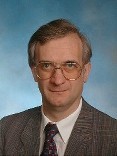| |
Definition of Passive Houses |
|
|
The drawing illustrates the basic principle of a Passive House: Ventilation has to deliver at least the fresh air required for an acceptable indoor air quality. Isn´t it possible to use just this amount of air to heat (and cool) the house? - Yes, in principle this is possible, but the maximum heat load which can be dealed with by this concept ist very low. This is the calculation to derive the "condition for Passive Houses": From experience (and DIN 1946) we know, that 30 m³/h is a minimum air rate per person to maintain a reasonable indoor air quality (Yes, in airoplanes you often get only 12 or 15 m³/h. But - is this a reasonable good indoor air quality?). Air has a specific heat capacity of 0,33 Wh/(m³K) (at 21°C). It is allowed to increase the fresh air temperature by 30 K, not more, to avoid pyrolysis of dust. You get 30 m³/h/Pers · 0,33 Wh/(m³K) · 30 K = 300 W/Pers That shows: 300 Watt per person can be delivered by a fresh air heating system. If you have e.g. 30 m² living space per person, you get 10 W per m² living space. This value is independend of the climate. So far all values are peak load values, that is the maximum heat capacity needed at design conditions. In dependence of the external climate Passive Houses will have to be insulated to a different level: More insulation in Stockholm, less in Roma. It is important to distinguish heat load values (power in W (Watts)) from annual consumption values (heat or energy in kWh). In a Central European climate from experience and simulation we now, that typical heatig energy consumptions of Passive Houses are some 15 kWh/(m²a) - but these are only raw figures. In Stockholm it could be up to 20, in Roma more like 10 kWh/(m²a).
|
| The Passive House is not an energy performance standard, but a concept to achive highest thermal comfort conditions on low total costs - this is the correct definition: "A Passive House ist a building, for which thermal comfort (ISO 7730) can be achived solely by postheating or postcooling of the fresh air mass, which is required to fullfill sufficient indoor air quality conditions (DIN 1946) - without a need for recirculated air." This is a purely functional definition. It does not need any numerical value and it is independend of climate. From this definition it is clear, that the Passive House is not an arbitrary standard enacted by somebody, but a fundamential concept. Passive Houses have not been "invented", but the conditions to use the passive principle has been discovered. One could argue about, whether the noun "Passive House" is adequat to denote this concept. Well - there is no better one. Thermal comfort is delivered in a Passive House by passive measures as far as reasonable (insulation, heat recovery in the temperature gradient, passive utilized solar energy and internal heat loads). To use only passive measures might be possible in some climates - but it will not be reasonable in most of them. An even better understanding
we get from the following practical considerations: Remark for readers from America: You are used to have air based heating and cooling systems (thats why you call it "air conditioning"). But the systems used in America are almost all just recirculating indoor air at a quite high rate (> 10 ach, but the air is not "changed", it is just recirculated). The system discussed here is something very different: It replaces the indoor air with a very low rate (0.3 to 0.6 ach) with external air to maintain a good indoor air quality. There is no recirculated air. The airflows are much lower, there is almost no noise and no draft at all. Well, the use of such a system might be very similar to the ones you are used to - but quite more comfortable. 2) This concept makes it possible, to construct buildings with a very efficient heat recovery and to do that cost-effective. This is difficult in other cases, because heat recovery systems form a quite expensive additional investment to the heating system - normally it is difficult to have a reasonable pay-back-time. Therefor it is a good idea to reduce costs of at least one of the two systems: The ventilation or the heating system. If one reduces costs for the ventilation systems by choosing e.g. just an exhaust fan ventilation, then the ventilation heat losses will be quite high and the building will need a conventional heating system - in this case the result could be a low energy house. Or the heating part is simplified in a way, that it can be integrated into the ventilation system - in that case the building will be a passive house. The extraordinary low consumptions of passive houses are just a direct consequence of the concept given above. To deliver all the space heating just by heating with fresh air can only work, if the overall heat losses are very low. Therefor the insulation of the building envelope has to be very good - at lest in cold climates. But the same holds for hot climates, if the fresh air supply has to be sufficient for airconditioning. (updated:
2006-09-23 |
